If you’re looking for a workout that provides all-over fitness benefits, look no further than circuit training. A circuit workout is just a resistance workout with little to no rest between exercises. But the absence of extended rest periods makes circuit training as effective as a cardio-based high-intensity interval workout (HIIT), which raises your heart rate and metabolism and burns lots of calories — not just during the workout, but for hours afterward. (See “HIIT It!”.) And because you’re using resistance, you also build muscle. “Circuit training combines the benefits of cardio exercise and resistance exercise better than any other activity,” says Jason C. Brown, CSCS, owner of Kettlebell Athletics in Philadelphia, Pa.
Need proof? A 2000 study conducted by researchers at the University of Oulu in Finland and published in the Scandinavian Journal of Medicine and Science in Sports found that 90 sedentary adults who completed a 12-week circuit-training program improved their cardiovascular fitness as much as participants who walked, jogged, cycled and cross-country skied. They also improved their strength — something the other group failed to do.
“A properly designed circuit workout provides a challenge for anyone,” says Juan Carlos Santana, MEd, CSCS, CEO of the Institute of Human Performance in Boca Raton, Fla. Athletes have been using circuit training for decades, and sport-conditioning coaches favor it because it provides an effective team workout with minimal equipment. (For a minimal-equipment strength circuit, see “The Squeeze-It-In Strength Workout”.)
Guidelines for Effective Circuit Training
The key to a properly designed circuit workout is exercise selection. “Emphasize multijoint movements that use a lot of muscle mass,” says Santana. Why? Your heart rate and metabolic rate are a function of the total volume of muscle mass you activate. Therefore, a circuit made up of multijoint, whole-body movements burns more calories and teaches better movement skills. Exercises should be fairly simple, he adds, so they can be performed safely and effectively — especially toward the end of the workout when you start to get tired.
Avoid exercises that require a lot of setup, and keep the equipment to a minimum so you don’t waste time transitioning from one workout to the next, advises Brown. “In circuit training,” he explains, “minimizing rest time between exercises is as important as the exercises themselves.” The more downtime you have between movements, the more your heart rate and metabolic rate decrease.
Within these parameters, you can perform a variety of circuit workouts. You may choose to perform exercises by repetitions or by time. You may also choose to do strength-focused circuits, cardio-focused circuits or a combination of both. Read on for an example of a circuit that emphasizes strength.
Circuit-Training Basics
Here’s how to create your own strength circuit:
- Choose four to six multi-joint exercises that cover the whole body.
- Arrange your exercises so that no two consecutive exercises work the same muscle group.
- Decide whether to perform exercises by time or by number of repetitions.
- If you wish, insert a brief segment of cardio activity (e.g., 30 to 60 seconds of jumping rope) or stretching between exercises.
- Warm up and then complete the full circuit one to four times, depending on your fitness level.
Santana created this circuit to provide a total-body workout with just four moves and dumbbells of various sizes. Begin by doing the following three-step warm-up:
The Workout
Warm-Up
(1) Overhead Dumbbell Chop
This exercise increases blood flow to nearly every muscle of your body, getting them ready for your workout.

- Standing with feet slightly wider than shoulder-width apart, grip the handle of a dumbbell with both hands and hold it directly overhead as shown, with a slight bend in your elbows.
- Squat down as though you are going to sit in a chair, and at the same time, swing the dumbbell down between your legs as if to chop in half a watermelon on the floor.
- Stop when the lower head of the dumbbell reaches ankle height, and return to the starting position.
- Continue for 30 seconds.
(2) Standing Trunk Rotation
This exercise establishes a connection between your brain and core muscles, helping activate your core for the workout to come.

- Stand with a dumbbell held vertically in both hands and your arms extended in front of you, hands at mid-torso level.
- Rotate your hips and trunk to the right and pivot onto the toes of your left foot. Rotate a full 90 degrees, stop, and then rotate 180 degrees to the left, pivoting on your right foot this time.
- Continue rotating back and forth for 30 seconds.
(3) Diagonal Dumbbell Chop
This exercise elevates your heart rate for a smooth transition into the meat of your workout.

- Stand with a dumbbell held in both hands, arms extended in front of you and hands at mid-torso level. Rotate your hips and trunk to the right and reach upward as though to place the dumbbell on a high shelf above and just behind your right shoulder. Keep your elbows extended and pivot your left foot slightly as you reach upward.
- Now rotate in the opposite direction, bending down as though to put the dumbbell on a step located one foot to the left of your left foot.
- Return to the starting position and perform the mirror image of this movement (swinging the dumbbell high and to the left and then low and to the right).
- Continue for 30 seconds.
Dumbbell Circuit
After completing your warm-up, do the following circuit. Perform each exercise, repeating as necessary for a total of 30 seconds, rest 10 to 30 seconds and then move on to the next exercise. Repeat the circuit four to six times.
One-Legged Deadlift
The one-legged deadlift is a terrific strengthener for the hamstrings, glutes, hips and lower back. Plus, it has a balance component, which gets the core muscles involved.
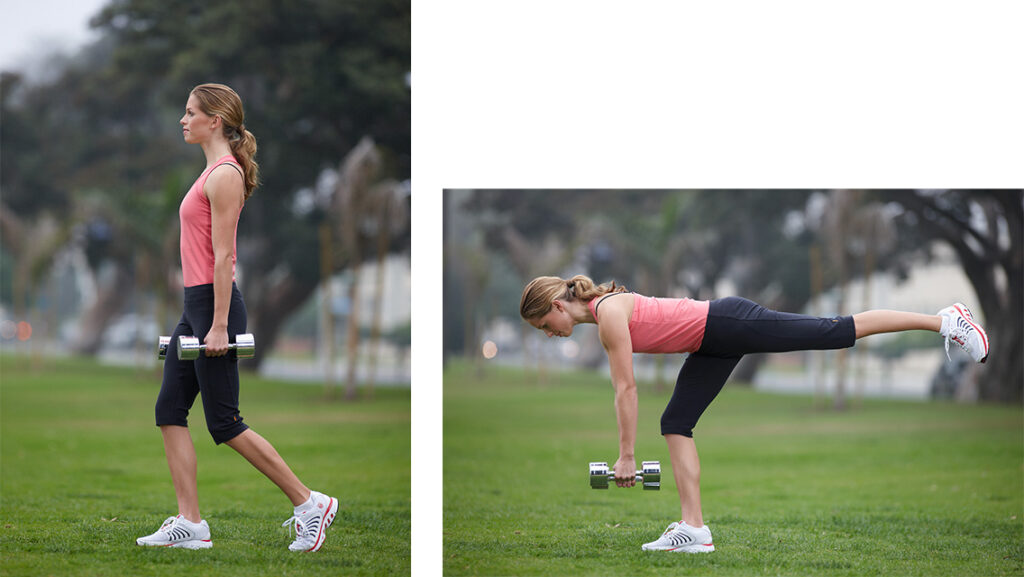
- Start by standing on your right foot with your knees slightly bent, arms extended at your sides and a dumbbell in each hand. Bend forward at the hips and reach toward a spot on the floor just in front of your right foot with both dumbbells. Extend your left leg behind you for balance with the knee slightly bent.
- Stop when the dumbbells reach ankle height and return to the starting position. Be sure to keep your core muscles tight throughout this movement, and move from the hips, which should remain neutral (be careful they don’t tilt to the side as you bend over).
- Continue for 30 seconds on the right foot and then switch sides for another 30 seconds.
Squat and Curl
As its name suggests, this exercise is a composite of two separate exercises: a squat, which strengthens the quads, hamstrings, glutes and lower back; and a biceps curl, which strengthens the biceps and forearms.
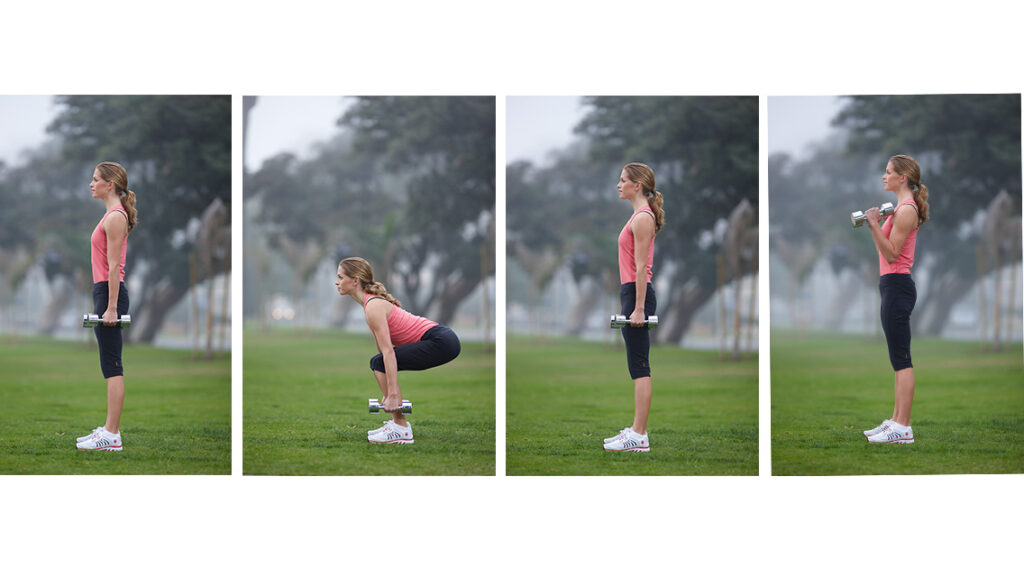
- Stand with your feet shoulder-width apart, your arms extended at your sides and a dumbbell in each hand.
- Lower your butt toward the floor as though you’re going to sit in a chair behind you; don’t let your knees extend past your toes. Keep your core tight and your chest up — avoid rounding your back. Stop when the dumbbells reach the height of your lower calves and
- return to the starting position, keeping your weight on your heels throughout.
- Now bend your elbows and curl the dumbbells up toward your shoulders, using a hammer grip. Return once more to the starting position.
Overhead Press
The simple overhead press is one of the best shoulder strengtheners there is.
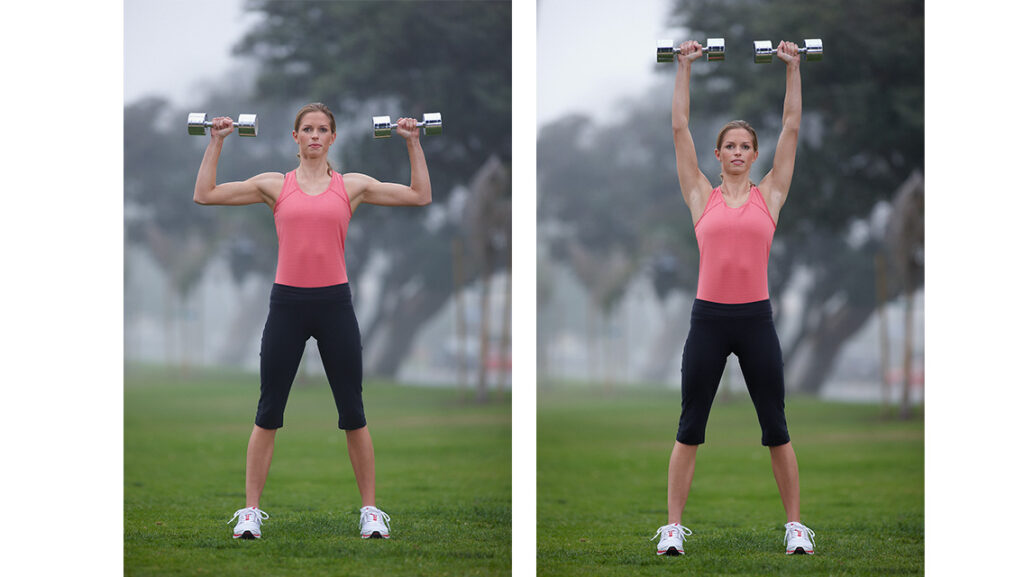
- Stand with a dumbbell in each hand, elbows sharply bent and pointing outward, the dumbbells just above your shoulders.
- Press the dumbbells straight overhead. Pause briefly with your arms fully extended and return to the starting position.
Cross-Punching
This dumbbell exercise will help you develop svelte muscles in your torso, chest, shoulders and upper back.
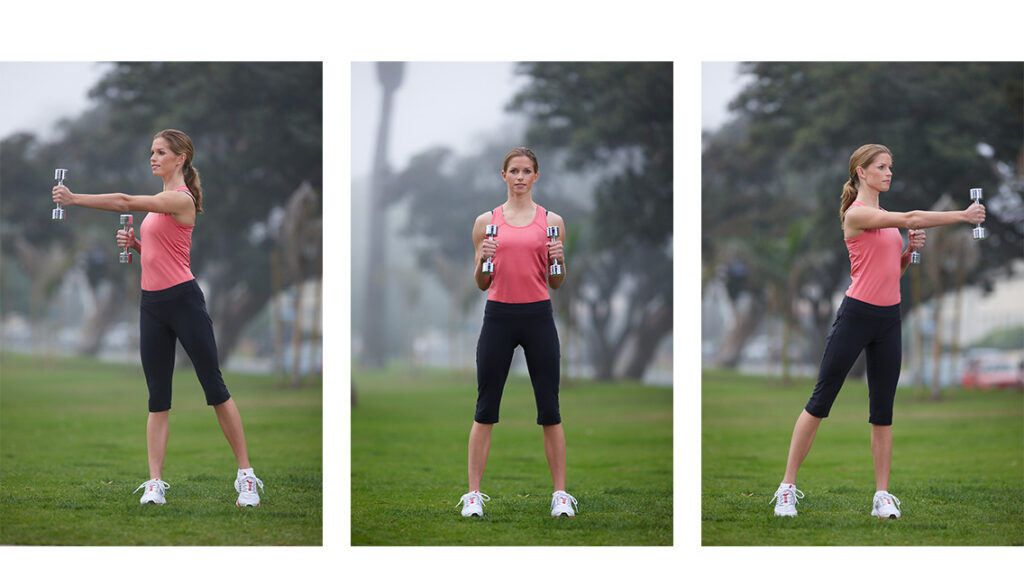
- Standing with your feet slightly more than shoulder-width apart, hold a light dumbbell in each hand and bend your elbows sharply so that the dumbbells are in front of your shoulders, handles perpendicular to the floor.
- Now twist your hips to the right and throw a jab across your body with your left arm (keeping the handle of the dumbbell perpendicular to the floor). Push up onto the toes of your left foot as you twist. Return to the starting position and immediately throw a jab across your body with your right arm.
Variety is important in any fitness program. If you choose to make circuit workouts a staple of your regimen, vary the exercises and structure to stimulate ongoing progress in your strength, endurance and body composition.
Then, with the time you save by combining your strength and cardio workout, you can take up a new sport — or just kick back and bask in your newfound power.
Productive Play
A do-anywhere body-weight circuit designed by Jason C. Brown, CSCS, owner of Kettlebell Athletics in Philadelphia, Pa.
There’s no rule that says a circuit workout has to take place under a roof. This body-weight circuit, designed by Jason C. Brown, CSCS, owner of Kettlebell Athletics in Philadelphia, Pa., can be done on a grass playing field, at the beach and just about anywhere else with room to run.
Begin with a five- to 10-minute warm-up that includes light jogging, followed by skipping (just like you did on the playground many years ago) and a few mobility exercises, like “Toy Soldiers”: Walk forward with both arms extended straight ahead. Kick your leg up and try to touch your toe to your hand with each step. Complete 10 steps per leg.
After completing your warm-up, complete the following circuit of alternating calisthenics exercises and high-intensity running intervals. Complete the full circuit just once if you’re a beginner and twice if you’re advanced.
Body-weight Squat
Stand normally. Lower your butt toward the ground as if you were about to sit on a chair, and at the same time extend your arms straight in front of you for counterbalance. Stop when your thighs are parallel to the ground and return to the starting position. Repeat for one minute.
200-Meter Run
Sprint half a lap around a standard running track or equivalent distance. To modify this workout for confined spaces, do 45 seconds of skipping rope instead of the 200-meter runs.
Dive Bomber
Assume a pushup position, only with your hands and feet placed slightly closer together than they would normally be and your butt high in the air (like you’re going a downward dog yoga pose). Your arms and legs should be extended. Next, imagine your hands are positioned beneath a low wire that you need to sneak under. Swoop down and forward, nose first, until your chin passes between your hands and within an inch of the floor, and then straighten your elbows so that your back arches and your head comes up. Return to the start position by performing the same swooping motion in reverse. Continue for one minute.
200-Meter Run
Reverse Lunge
Stand normally with your arms hanging at your sides. Take a long step backward with your right leg while keeping the majority of your weight on your left heel and maintaining an upright torso posture. Use the left leg to decelerate your descent. Propel your body back up to the starting position. Now lunge back with the left leg. Continue for one minute.
200-Meter Run
Mountain Climber
Start in a pushup position. Bend your right knee and bring your right foot up to the floor beneath your chest. Press off the floor with both feet and reverse the position of your legs in midair, landing with your left foot under your chest and your right leg extended. Continue jumping and reversing your legs continuously for one minute.
200-Meter Run
After completing your last 200-meter run at 90 percent effort, cool down with five minutes of easy jogging.
This article originally appeared as “Making the Rounds” in the April 2009 issue of Experience Life.
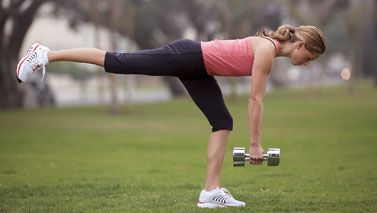


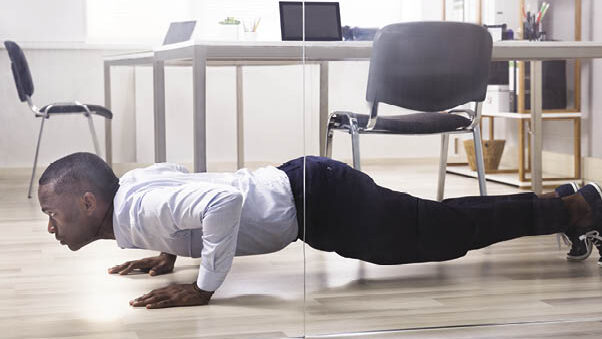
This Post Has 0 Comments